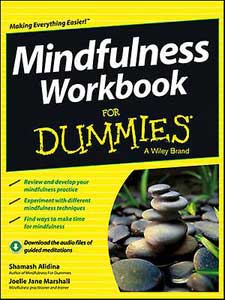I first learned about mindfulness when I was nine years old back in the early 60s when my grandmother would say a Christian prayer and blessing before family holiday meals, which included the phrase “…and make us ever mindful of the needs of others.” Wanting to know what that meant, I began my exploration of what mindfulness is all about, and how one could attempt to become “ever mindful.” Like most, I quickly learned that the two thousand+ year old practice of mindfulness was an integral part of the Buddha’s teachings; yet it is also expressed and practiced in some form in many faiths and philosophies around the world.
In both my professional work and my personal meditation practice, I’d observed over the years that mindfulness practice itself is exceptionally transformative.
The global existence of diverse mindful awareness skill building practices I’d discovered as a child framed my journey along the path of learning and exploration, and I also studied several other forms of meditation and self-awareness tools and teachings that are complimentary with what I learned from Buddhist teachings. By the time I read Jon Kabat-Zinn’s Full Catastrophe Living: Using the Wisdom of Your Body and Mind to Face Stress, Pain, and Illness when it was first published in the early nineties, I was both a certified massage therapist and clinical hypnotherapist working with the scientifically acknowledged mind-body relationship. I took an early course in Mindfulness Based Stress Reduction (MBSR) in San Francisco, and found immense benefit in the application of Kabat-Zinn’s work with my clients.
I was a self-described “Heinz 57/spiritual mutt” by then. Having found deep value and meaning in the various ancient and contemporary teachings I’d explored during the prior thirty-odd years, as much as I deeply revere Buddhist philosophy and have adopted many practices from it, I did not feel alignment with any one path toward higher conscious awareness was right for me. In both my professional work and my personal meditation practice, I’d observed over the years that mindfulness practice itself is exceptionally transformative. I quietly worked with individual clients and small groups, combining mindfulness and the various mind-body awareness building tools I’d learned, way before the internet connected people who were also incorporating secular mindfulness practices in both alternative health care as well as part of the human potential/growth movement that was blossoming all around the planet.
Right after that, online turf wars began to arise, wherein Buddhist practitioners were fighting with secular practitioners. I was verbally attacked by Buddhists in the new frontier of internet forums and discussion boards, who were worried that “non-Buddhist people like me” would destroy the purity of mindfulness itself.
Fast forward to 2009. I was writing a monthly “Living Mindfully” column for a metaphysical publication based in Atlanta, and the secular version of mindfulness that Kabat-Zinn had been promoting through MBSR, and its adoption in scientific research was really beginning to explode. I wrote a column titled “Mindfulness-Based Trainings: Caveat Emptor” (reprinted here) about what I foresaw could happen if what I termed “mindfulness lite” became the “new trend.” Right after that, online turf wars began to arise, wherein Buddhist practitioners were fighting with secular practitioners. I was verbally attacked by Buddhists in the new frontier of internet forums and discussion boards, who were worried that “non-Buddhist people like me” would destroy the purity of mindfulness itself. Yet as the saying goes, there was no putting the horse back into the barn. 2014 was termed the “year of mindfulness” by JWT Worldwide, one of the world’s largest marketing communications brands, and other teachers had formed their own versions of secular mindfulness trainings, bringing it into the workplace to not only help reduce stress (like MBSR was originally intended to do), but also to improve employee attention, performance and productivity, and nurture more consciously mindful leadership.
This unfortunately began to create an atmosphere of competition wherein some companies offering mindfulness trainings started to fiercely (and legally) attempt to protect their “brand” – and other long-time teachers were arguing that “their” way is the only authentic way to teach mindfulness as the Buddha brought it into the world – certainly an unintended consequence of mindfulness becoming adopted into mainstream, Western capitalistic culture. Concern over “sullying” the purity of the ancient traditions of mindfulness through Westernized secularization where teaching about universal ethics have often been stripped, and which “official” teacher certifications are professionally acceptable (and where) is understandable. So is the fact there are opportunists who, usually with little training, put themselves forth as mindfulness “experts” who are often just adding another income stream to their offerings – yet don’t have the years of practice under their belt that both humbles and empowers them to responsibly teach this work to others. An understandable backlash has arisen in response to teachers who are unskilled in attending to the “stuff” that can come up from meditation practice.
However, another troublesome issue of concern is the growing division, posturing and competitiveness that is taking place between teachers of the various mindfulness trainings, now that there is money to be made by teaching mindfulness in the professional realm – and the fact that larger mindfulness training companies simply have more marketing dollars than smaller ones do.
My fellow Partners at The Mindful Globe are all passionate and reverent teachers of mindfulness – and each of us celebrates and honors our diversity as teachers wherein we see that the sum of our parts creates an overflowing wholeness of learning opportunities.
Fortunately, in their dedicated service to mindfulness itself, many mindfulness teachers from all backgrounds and formats are seeing that fear-based separation, elitism, in-fighting and grasping can turn this beautiful gift that no one can own into an ego-filled Pandora’s box that could turn off countless people who can benefit from this work. My fellow Partners at The Mindful Globe are all passionate and reverent teachers of mindfulness – and each of us celebrates and honors our diversity as teachers wherein we see that the sum of our parts creates an overflowing wholeness of learning opportunities. Some are Buddhists, and some are not; some use well-known approaches – and some don’t – and we are seeing that collaboration and support is what our service to mindfulness itself requires. We affirm that there is no one perfect training – or teacher for that matter – to learn mindfulness from. In fact, providing students and clients with complimentary and supportive perspectives acknowledges that we’ve all have had many teachers along the way ourselves.
One cannot expect that mindfulness practice itself would not evolve from its ancient roots. It is enhanced by the addition of practices like emotional intelligence and guided visualization – neither of which is a mindfulness practice itself – yet both can help to increase mindful awareness. The ability to clinically demonstrate the effectiveness of mindfulness practices upon both our personal wellness and our work life is a boon, and His Holiness the Dalai Lama is to be commended for bringing in the validation of scientific studies – but lets not invalidate anecdotal evidence in the process simply because science “sells” better. And at the same time, in honoring the wholeness of human beings in the workplace – it is important to also honor the wholeness of mindfulness too, and not over focus on one area where mindfulness practices can measurably benefit employees, yet neglect other, less quantifiable ones just so we can more easily promise a replicable ROI. When we try to put mindfulness in a rigid box and follow a tight script and format, we cannot be purely in the moment with the student(s) or client(s) in front of us. After all, sometimes we may need to color outside the lines.
As a mindfulness educator and/or coach in any arena of application, own your own mind and trust the wisdom of your own heart. No teacher of mindfulness in any form must ever forget how mindfulness has enriched his or her life, or the moment you knew you wanted to serve others with it as well. Listen to, learn from, and support the diversity of approaches to mindfulness education available, and always always always return to beginner’s mind as you teach what gave so much to your own life.
Even if you may have conscious and unconscious biases around the forms of mindfulness education available, I invite every teacher to choose to focus upon our collective honorable intentions, and the beauty and power of diversity and unity that we can support in one another. United we stand, and divided – well, everyone loses – and especially mindfulness itself. If you view other teachers/trainings as a threat to yours, check to see if that is your ego speaking, and reflect upon if you may be coming from a scarcity or elitist mindset. Know the pie is big enough for an infinite number of slices, and trust that any potential student or client will connect with the teachers/trainings that resonate best with him or her in any given point along their own journey of mindfulness – and it may or may not include yours. Let go of any sense of “ownership” that finds you attached to any particular format of teaching the core principles of mindfulness that basically everyone teaches.
Excerpted from the aforementioned “Living Mindfully” column I wrote back in 2009:
Doing the work of radical self-inquiry to unveil the shadow qualities and bugs in their internal operating system that hold them back from growing, and committing themselves with gratitude and humility to actualize transparency between what they profess to believe, the ideals they align with personally and professionally, and how they treat others in every moment of every day as a form of egoless service to humanity is the bodhisattva/spiritual warrior way. It is vital to recognize that all who are genuinely moved to teach this work consider it a calling, complete with every speck of responsibility to whom they share their knowledge, as their reverence for their fellow human beings and mindfulness itself is so immense they are more than “qualified.” Let this be your main criteria for choosing someone to assist you along the way, not merely their academic titles, their number of social media followers, whether or not they are a New York Times best-selling “mindfulness celebrity” author, the big corporate clients they list, nor the “brand name” (or none at all!) of the mindfulness courses they teach.
Take a moment each day to extend gratitude to all the dedicated teachers and students who are midwives in the birth of growing states of more mindful, conscious awareness within our fellow human beings, and the light that each one brings to the world to help to “…make us ever mindful of the needs of others.”
© 2009, 2016, Suzanne Matthiessen/holisticmindfulness.org



